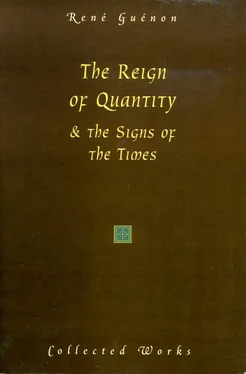The materialistic attitude, because of its inherent limitations, involves risks that are similarly limited; its ‘thickness’, figuratively speaking, protects anyone who persists in holding to it from all subtle influences without distinction, and confers on him a sort of immunity more or less like that of a mollusc living firmly enclosed in its shell, the materialist deriving from this immunity the impression of security previously referred to. The shell may be taken to represent the aggregate of conventionally recognized scientific conceptions and of the corresponding mental habits, together with the ‘hardening’ of the ‘psycho-physiological’ constitution of the individual which they produce, [114] It is of interest to note that the expression ‘hardened materialist’ is freely used in current speech, doubtless without any suspicion that it is no mere figure of speech, but actually corresponds to something very real.
and if an opening is made in this shell from below, as described earlier, the destructive subtle influences will at once make their way in, and they will do so all the more easily because, thanks to the negative work accomplished in the preceding phase, no element of a superior order will be able to intervene in such a way as to counteract them. It could also be said that the period of materialism constitutes no more than a sort of preparation, predominantly theoretical, whereas the period of inferior psychism introduces a ‘pseudo-realization’ leading in exactly the opposite direction to that of true spiritual realization, but a fuller explanation of this last point must await a later chapter. The paltry security of ‘ordinary life’, which was the inseparable accompaniment of materialism, is indeed from now onward seriously threatened, and it will no doubt soon be seen more and more clearly, and by more and more people, as having been a mere delusion; but what advantage can this perception bring, if its sole result is an immediate fall into another delusion, worse and more dangerous from every point of view, because it involves consequences much more extensive and more profound? This other delusion is that of an ‘inverted spirituality’, and the various ‘neo-spiritualist’ movements that have arisen and reached a certain development in our times, not excepting those which already show a more definitely ‘subversive’ character, still represent no more than a weak and tentative prelude to it.
25
The Fissures in the Great Wall
However far the ‘solidification’ of the sensible world may have gone, it can never be carried so far as to turn the world into a ‘closed system’ such as is imagined by the materialists. The very nature of things sets limits to ‘solidification’, and the more nearly those limits are approached the more unstable is the corresponding state of affairs; in actual fact, as we have seen, the point corresponding to a maximum of ‘solidification’ has already been passed, and the impression that the world is a ‘closed system’ can only from now onward become more and more illusory and inadequate to the reality. ‘Fissures’ have been mentioned previously as being the paths whereby certain destructive forces are already entering, and must continue to enter ever more freely; according to traditional symbolism these ‘fissures’ occur in the ‘Great Wall’ that surrounds the world and protects it from the intrusion of malefic influences coming from the inferior subtle domain. [115] In the symbolism of the Hindu tradition the ‘Great Wall’ is the circular mountain Lokāloka , which divides the ‘cosmos’ ( loka ) from the ‘outer darkness’ ( aloka ); and this symbolism is of course susceptible of analogical application either to more extensive or to less extensive domains within the totality of cosmic manifestation, hence the special application now being made with respect to the corporeal world alone.
In order that this symbolism may be fully understood in all its aspects, it is important to note that a wall acts both as a protection and as a limitation: in a sense therefore it can be said to have both advantages and inconveniences; but insofar as its principal purpose is to ensure an adequate defence against attacks coming from below, the advantages are incomparably the more important, for it is on the whole more useful to anyone who happens to be enclosed within its perimeter to be kept out of reach of what is below, than it is to be continuously exposed to the ravages of the enemy, or worse still to a more or less complete destruction. In any case, a walled space as such is not closed in at the top, so that communication with superior domains is not prevented, and this state of affairs is the normal one; but in the modern period the ‘shell’ with no outlet built by materialism has cut off that communication. Moreover, as already explained, because the ‘descent’ has not yet come to an end, the ‘shell’ must necessarily remain intact overhead, that is, in the direction of that from which humanity need not be protected since on the contrary only beneficient influences can come that way; the ‘fissures’ occur only at the base, and therefore in the actual protective wall itself, and the inferior forces that make their way in through them meet with a much reduced resistance because under such conditions no power of a superior order can intervene in order to oppose them effectively. Thus the world is exposed defenceless to all the attacks of its enemies, the more so because, the present-day mentality being what it is, the dangers that threaten it are wholly unperceived.
In the Islamic tradition these ‘fissures’ are those by which, at the end of the cycle, the devastating hordes of Gog and Magog will force their way in, [116] In the Hindu tradition they are the demons Koka and Vikoka , whose names are obviously similar.
for they are unremitting in their efforts to invade this world; these ‘entities’ represent the inferior influences in question. They are considered as maintaining an underground existence, and are described both as giants and as dwarfs; they may thus be identified, in accordance with what was said earlier on the subject, and at least in certain connections, with the ‘guardians of the hidden treasure’ and with the smiths of the ‘subterranean fire’, who have, it may be recalled, an exceedingly malefic aspect; in all such symbolisms the same kind of ‘infra-corporeal’ subtle influences are really always involved. [117] The symbolism of the ‘subterranean world’ is twofold, and, as in other cases, it also has a superior meaning, a point more particularly explained in some of the considerations set out in The King of the World ; but naturally only the inferior meaning is here in question, a meaning which could be said to be literally ‘infernal’.
If the truth be told, the attempts of these ‘entities’ to insinuate themselves into the corporeal and human world are no new thing, for they go back at least to somewhere near the beginning of the Kali-Yuga , a period far more remote than that of ‘classical’ antiquity, by which the horizon of profane historians is bounded. In this connection, the Chinese tradition relates in symbolical terms that ‘Niu-koua [sister and wife of Fu Hsi, who is said to have reigned jointly with him] melted stones of five colors [118] These five colors are white, black, blue, red, and yellow, corresponding in the Far-Eastern tradition to the five elements, as well as to the four cardinal points and the center.
in order to repair a tear in the sky made by a giant’ (apparently, though it is not made quite clear, the tear was situated on the terrestrial horizon); [119] It is also stated that ‘Niu-Koua cut off the four feet of the tortoise to put the four extremities of the world in their place,’ so as to stabilize the earth; reference to what was said earlier about the analogical correspondences between Fu Hsi and Niu-koua will make it clear that the function of ensuring the stability and ‘solidity’ of the world belongs, according to this symbolism, to the substantial side of manifestation, and this agrees exactly with all the explanations given in this book on that subject. [Guénon provides no references in his French text for these citations regarding Niu-koua, but see Symbols of Sacred Science , chap. 20. Ed.]
and this took place at a period not more than a few centuries after the beginning of the Kali-Yuga .
Читать дальше











